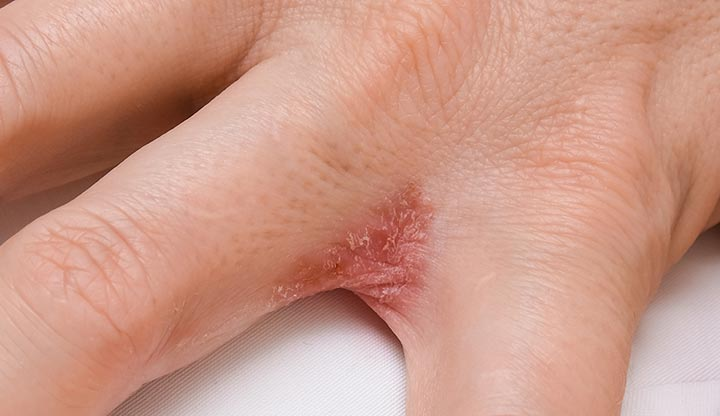As the weather warms up, many of us start to enjoy the outdoors a bit more. However, if you’re dealing with eczema, particularly dyshidrotic eczema, those sunny days might come with a painful reminder of a chronic skin condition. Dyshidrotic eczema tends to flare up during the warmer months, causing painful, itchy bumps on your skin. If you’ve noticed small blisters forming on your hands or feet, it could be a sign of this common condition. While there’s no permanent cure for eczema, understanding your symptoms is the first step toward managing them and reclaiming your skin health.
What is Eczema?

Eczema, also known as dermatitis, refers to a group of skin conditions that cause inflammation. It is estimated that 35 million Americans suffer from eczema, and 70% of those cases begin before the age of 5. Symptoms of eczema include red, itchy patches on the skin, which may sometimes ooze or crust. While eczema is often triggered by an allergic reaction, it’s important to note that it is not contagious. Though eczema isn’t curable, it is highly manageable with the right treatment and care. Dyshidrotic eczema, a specific type of eczema, can cause a significant amount of discomfort, especially during flare-ups.
Understanding Dyshidrotic Eczema
Dyshidrotic eczema, also referred to as pompholyx or vesicular eczema, is a common form of eczema that specifically affects the hands and feet. The hallmark of dyshidrotic eczema is the appearance of small, intensely itchy blisters on the edges of the fingers, toes, palms, and soles. These blisters can cause significant discomfort and may take weeks to disappear. This form of eczema is most commonly triggered by seasonal allergies, with many people noticing flare-ups during the spring and summer months.
Symptoms of Dyshidrotic Eczema
Dyshidrotic eczema presents itself in a few key ways. It’s important to know these signs so that you can recognize the condition early on. Some common symptoms include:
Video : Doctor explains how to recognise and treat HAND ECZEMA (dermatitis)
- Itchy, painful blisters: These blisters typically appear on the hands, feet, or the sides of fingers and toes.
- Redness and inflammation: Affected skin may turn red, swollen, and inflamed.
- Cracked, scaly skin: Once the blisters heal, the skin may become cracked and rough.
- Flaky skin: The skin can also begin to peel after a flare-up, which may lead to further irritation.
Recognizing these signs is crucial for early intervention, allowing you to treat the condition before it worsens.
What Causes Dyshidrotic Eczema?
While the exact cause of dyshidrotic eczema remains unclear, several factors contribute to its development. It’s more common in women than in men, and it typically affects individuals between the ages of 20 and 40. Here are some of the primary triggers and risk factors for dyshidrotic eczema:
- Seasonal Allergies: As the condition is linked to seasonal changes, particularly spring, individuals with allergies to pollen or dust may experience flare-ups.
- Genetics: If you have a close relative with eczema or other skin conditions, you are at a higher risk of developing dyshidrotic eczema.
- Contact Dermatitis: People with a history of contact dermatitis are more susceptible to developing this condition.
- Stress: High stress levels have been shown to trigger or worsen eczema symptoms.
- Sweating: Excessive sweating, especially in hot and humid environments, can also provoke flare-ups.
How to Treat Dyshidrotic Eczema on Hands and Feet
While there is no cure for dyshidrotic eczema, the good news is that it can be effectively managed. A combination of medical treatments and natural remedies can help ease the symptoms and reduce flare-ups. Here are some common treatments:

Conventional Treatment Options
- Topical Steroids: Doctors may prescribe corticosteroid creams or ointments to help reduce inflammation and relieve itching.
- UV Light Therapy: This treatment involves exposing the skin to controlled amounts of ultraviolet (UV) light to help reduce inflammation.
- Antihistamines: These can help control itching and reduce allergic reactions that might trigger flare-ups.
- Antibiotics: If the eczema becomes infected, antibiotics may be required to treat the infection.
- Immune-Suppressing Ointments: Ointments like Protopic or Elidel can help reduce inflammation and control eczema flare-ups.
Natural Remedies for Dyshidrotic Eczema
In addition to conventional treatments, many people prefer to try natural remedies to manage their symptoms. Here are a few that have shown promise:
- Cold Compresses: Applying cold compresses to the affected area can help reduce inflammation and provide relief from itching.
- Aloe Vera: Aloe vera gel is known for its soothing and healing properties, making it an excellent remedy for inflamed skin.
- Oatmeal Baths: Oatmeal has anti-inflammatory properties and can help soothe irritated skin. Adding colloidal oatmeal to a bath can provide relief for larger areas of the body.
Moisturizing and Skin Care
One of the most important aspects of managing eczema is keeping the skin moisturized. Use thick, fragrance-free emollients to lock in moisture and protect the skin from further irritation. It’s also important to avoid harsh soaps and hot water, as they can strip the skin of its natural oils.
Video : Dyshidrotic Eczema
Preventing Dyshidrotic Eczema Flare-Ups
While it’s not always possible to prevent eczema flare-ups, certain steps can minimize the risk:
- Avoid triggers: Keep track of what triggers your flare-ups and avoid those factors whenever possible (e.g., allergens, stress).
- Maintain a consistent skincare routine: Regularly moisturizing and using gentle skincare products can help manage symptoms.
- Wear breathable clothing: Tight or synthetic fabrics can irritate the skin, so opt for loose, cotton clothing.
Conclusion: Managing Dyshidrotic Eczema for Healthier Skin
Dyshidrotic eczema can be a frustrating condition to deal with, especially during seasonal flare-ups. However, with proper treatment and a solid skincare routine, managing the condition is entirely possible. Understanding the symptoms, triggers, and treatment options available empowers you to take control of your skin health. If you believe you’re dealing with dyshidrotic eczema, consult with a dermatologist to receive an accurate diagnosis and personalized treatment plan. By following a proactive approach and staying informed, you can keep your eczema under control and continue to enjoy life without the discomfort and embarrassment that eczema can cause.


